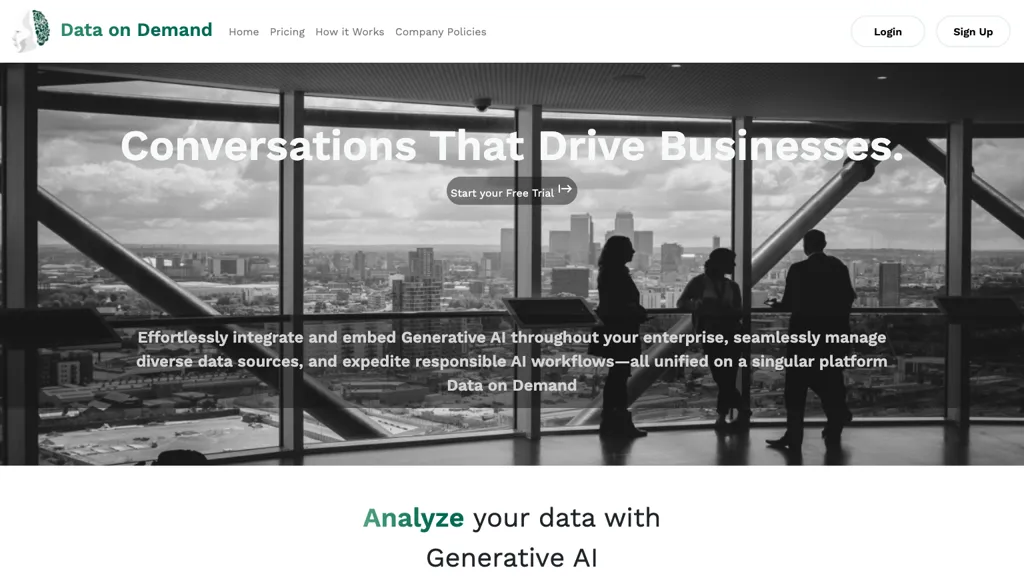What is Data on Demand?
Data on Demand is a versatile AI tool designed to make the integration of generative AI across various business operations seamless.
The app powers enterprises through handling of varied sources of data, fast-tracking responsible AI workflows, and making sure decisions are fast and with minimal hassle.
The platform empowers firms to extract relevant data on the blink, analyze it for pertinent data patterns and trends, and compellingly represent complex datasets. Unlock challenges to be faced with readiness for business and actionable recommendations by decoding stories in the data.
Key Features and Benefits of Data on Demand
Seamless Integration:
Easily integrates generative AI to the last person in an enterprise.
Data Management:
Efficiently deals with varied data sources.
Expedited Workflows:
Speeds up responsible AI workflows.
Data Extraction and Analysis:
Extracts only pertinent data efficiently and analyzes them.
Data Visualization:
Visualizes complex datasets in an understandable format.
With these functionalities, Data on Demand drives lessening dependencies on analysts and enhances operational efficiency while improving accuracy in predicting consumer demand. This full end-to-end solution instills better business results through data-driven decisions.
Data on Demand Use Cases and Applications
Data on Demand can be an omnipotent tool in a business organization for streamlining data extraction from a wide variety of sources, conducting minute trend analysis, and presenting beautiful data visualizations to help make a decision quickly. Here are the use cases and applications:
-
Trend Analysis:
Businesses can analyze trends and patterns in their data to make informed decisions. -
Data Visualization:
Helps in the presentation of large, complex datasets through captivating visual representations for a better understanding and communication process. -
Operational Efficiency:
Optimize operational work processes with the help of AI-powered insights.
Finance, healthcare, retail, and manufacturing are the fields where Data on Demand can most easily be applied. This tool will be used by companies to make better decisions, to be more effective in their operations, and to be ahead in the competition.
How to Use Data on Demand
Following are just a few and very easy steps that are involved in using Data on Demand:
-
Sign Up:
Begin by signing up for free trial or pricing according to what your company requires. -
Integrate Your Data:
Bring all your diverse data resources into the platform for unified processing. -
Extract Your Data:
Use the tool to pull out the exact relevant data within a matter of moments. -
Deep Analysis:
Understand the patterns and trends in depth. -
Data Visualization:
Graphically present your data with nice graphical effects.
Recommendations for making the best use of Data on Demand:
-
Update Your Data Sources Regularly:
This helps analyze accurate data. -
Its Visualization Features:
Visualize data with the help of the platform’s capabilities for presenting results. -
Engage With the Insights:
Put into action the actionable recommendations spewed by the tool as a way of enhancing decision-making.
How Data on Demand Works
Data on Demand works using cutting-edge AI algorithms and models that have been developed to take on a variety of data sources for speeding workflows up. A technical view of how that happens is shown here:
It’s powered by generative AI, meaning data capture and management from a variety of sources is done easily and seamlessly. Analyzing textual information for pattern detection to provide actionable insight uses machine learning algorithms. Typically, the workflow includes data extraction, analysis, and visualization, which allows the user to be able to reveal underlying data stories and informed decision-making.
Pros and Cons of Data on Demand
Now Data on Demand has numerous advantages, but it is also necessary to walk through the pros and cons of the platform in this:
Pros:
- Easy integration: A tool that easily integrates generative AI across businesses.
- Efficient data management: This tool is very effective in handling multiple data resources.
- All analysis: Offers complete analysis and visualization of data.
- Actionable Insights: Deliver actionable recommendations based on data analysis.
Cons:
- Learning curve: The tool might take some time for the user to familiarize himself with all the features.
- Cost: The paid plans are pretty expensive for a small business.
Positive user comments overall denote that the tool really does facilitate increased decision-making and operational efficiency, even though there is a steep learning curve to consider as well as the cost factor.
Data on Demand: Frequently Asked Questions
What is Data on Demand?
Data on Demand is a generative AI-powered tool implemented in all corporate businesses for the purpose of data source management, accelerated workflow, and data-driven decision making.
How do I use Data on Demand?
Sign up for a free trial or a suitable pricing plan, integrate your data sources, extract and analyze data, and create visualizations for informed decisions.
What does Data on Demand price their product?
Data on Demand contains a free Starter Plan, the Professional Plan priced at $20 per month, and the Enterprise Plan, which is available for a custom price. Prices may always be checked on the official website.
What sectors can Data on Demand serve?
The Data on Demand can help extract, analyze, and visually represent data, helping users in the finance, medical, retail, and manufacturing industries.
Are there any disadvantages to utilizing the Data on Demand?
Disadvantages will be that this is a new tool, and the users need some time to adapt to the new environment. And for the lowest business, it may cost more. But the effectiveness of the tool in supporting decision-making and improving efficiency is still more than the cost of the tool.










